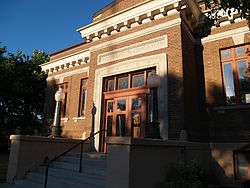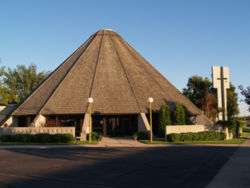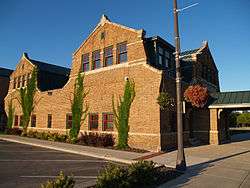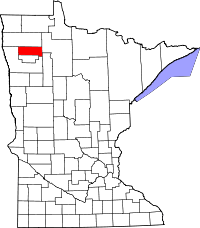Thief River Falls, Minnesota
| Thief River Falls, Minnesota | |
|---|---|
| City | |
|
Soo Line depot, now City Hall | |
 Location of the city of Thief River Falls within Pennington County, Minnesota | |
| Coordinates: 48°7′N 96°11′W / 48.117°N 96.183°W | |
| Country | United States |
| State | Minnesota |
| County | Pennington |
| Government | |
| • Mayor | Brian Holmer |
| Area[1] | |
| • Total | 5.21 sq mi (13.49 km2) |
| • Land | 5.02 sq mi (13.00 km2) |
| • Water | 0.19 sq mi (0.49 km2) |
| Elevation | 1,132 ft (345 m) |
| Population (2010)[2] | |
| • Total | 8,573 |
| • Estimate (2013)[3] | 8,716 |
| • Density | 1,707.8/sq mi (659.4/km2) |
| Time zone | Central (CST) (UTC-6) |
| • Summer (DST) | CDT (UTC-5) |
| ZIP code | 56701 |
| Area code(s) | 218 |
| FIPS code | 27-64570 |
| GNIS feature ID | 0653129[4] |
| Website | citytrf.net |
Thief River Falls, also called Thief River or TRF, is a city in Pennington County, Minnesota, United States. The population was 8,573 at the 2010 census.[5] It is the county seat.[6]
History
Thief River Falls takes its name from a geographic feature, the falls of the Red Lake River at its confluence with the Thief River. The name of the river is a loose translation of the Ojibwe phrase Gimood-akiwi ziibi, literally, the "Stolen-land river" or "Thieving-land river", which originated when a band of Dakota Indians occupied a secret encampment along the river, hence "stealing" the land, before being discovered and routed by the neighboring Ojibwe.[7] In the Treaty of Old Crossing of 1863, the Moose Dung's Indian Reservation was established on the west bank of the Thief River, at its confluence with Red Lake River. This Indian Reservation was dissolved in 1904 and their population incorporated as part of the Red Lake Band of Chippewa.
Thief River Falls marked the limit of navigation on the Red Lake River. The eponymous town site was established in 1887 and later incorporated as a city in 1896.[8] Thief River Falls first developed as a lumber-milling town. It is located in a major agriculture area because of the rich soil left by ancient Glacial Lake Agassiz. The Great Northern and the Soo Line railroads brought prosperity when Thief River Falls became a center for shipping wheat.
Geography
According to the United States Census Bureau, the city has a total area of 5.21 square miles (13.49 km2), of which 5.02 square miles (13.00 km2) is land and 0.19 square miles (0.49 km2) is water.[1]
Thief River Falls is located at the confluence of the Red Lake River and the Thief River. U.S. Highway 59 and Minnesota State Highways 1 and 32 are the three main routes in the community. Thief River Falls is located approximately 70 miles (110 km) south of the Canada–United States border and 52 miles (84 km) northeast from Grand Forks, North Dakota, in the Northwest region of Minnesota.
Demographics
| Historical population | |||
|---|---|---|---|
| Census | Pop. | %± | |
| 1890 | 191 | — | |
| 1900 | 1,819 | 852.4% | |
| 1910 | 3,714 | 104.2% | |
| 1920 | 4,685 | 26.1% | |
| 1930 | 4,268 | −8.9% | |
| 1940 | 6,019 | 41.0% | |
| 1950 | 6,926 | 15.1% | |
| 1960 | 7,151 | 3.2% | |
| 1970 | 8,618 | 20.5% | |
| 1980 | 9,105 | 5.7% | |
| 1990 | 8,010 | −12.0% | |
| 2000 | 8,410 | 5.0% | |
| 2010 | 8,573 | 1.9% | |
| Est. 2015 | 8,752 | [9] | 2.1% |
| U.S. Decennial Census[10] 2013 Estimate[3] | |||
According to the ethnic heritage section of the 2000 Federal Census, 50% of Thief River Falls residents identify themselves as Norwegian-American, making Thief River Falls one of the most ethnically concentrated towns in the nation.[11]
2010 census
As of the census[2] of 2010, there were 8,573 people, 3,802 households, and 2,141 families residing in the city. The population density was 1,707.8 inhabitants per square mile (659.4/km2). There were 4,061 housing units at an average density of 809.0 per square mile (312.4/km2). The racial makeup of the city was 92.0% White, 2.1% African American, 1.9% Native American, 0.7% Asian, 1.0% from other races, and 2.3% from two or more races. Hispanic or Latino of any race were 3.2% of the population.
There were 3,802 households, of which 27.6% had children under the age of 18 living with them, 39.0% were married couples living together, 12.2% had a female householder with no husband present, 5.2% had a male householder with no wife present, and 43.7% were non-families. 36.6% of all households were made up of individuals and 15.1% had someone living alone who was 65 years of age or older. The average household size was 2.18 and the average family size was 2.81.
The median age in the city was 37.6 years. 22.5% of residents were under the age of 18; 10.5% were between the ages of 18 and 24; 24.9% were from 25 to 44; 24.3% were from 45 to 64; and 17.7% were 65 years of age or older. The gender makeup of the city was 47.7% male and 52.3% female.
2000 census
As of the census of 2000, there were 8,410 people, 3,619 households, and 2,091 families residing in the city. The population density was 1,760.0 people per square mile (679.3/km²). There were 3,931 housing units at an average density of 822.7 per square mile (317.5/km²). The racial makeup of the city was 96.56% White, 0.27% African American, 0.95% Native American, 0.67% Asian, 0.04% Pacific Islander, 0.62% from other races, and 0.90% from two or more races. Hispanic or Latino of any race were 1.63% of the population.
There were 3,619 households, out of which 27.1% had children under the age of 18 living with them, 44.2% were married couples living together, 10.6% had a female householder with no husband present, and 42.2% were non-families. 35.1% of all households were made up of individuals and 15.7% had someone living alone who was 65 years of age or older. The average household size was 2.21 and the average family size was 2.84.


In the city the population was spread out with 22.4% under the age of 18, 11.7% from 18 to 24, 26.1% from 25 to 44, 20.9% from 45 to 64, and 18.8% who were 65 years of age or older. The median age was 38 years. For every 100 females there were 90.4 males. For every 100 females age 18 and over, there were 85.8 males.
The median income for a household in the city was $30,759, and the median income for a family was $40,908. Males had a median income of $30,332 versus $20,785 for females. The per capita income for the city was $17,489. About 8.0% of families and 12.4% of the population were below the poverty line, including 11.3% of those under age 18 and 15.7% of those age 65 or over.
Economy
Thief River Falls (and surrounding region) has been home to major industry including snowmobiles, farm machinery, and global electronics distribution. The town is the home of snowmobile manufacturer Arctic Cat. South of Thief River Falls is a casino, 7 Clans Casino, which also contains a hotel and indoor water park. Thief River Falls is home to the electronic parts distributor Digi-Key, one of the largest employers in the area, and was the birthplace of the vaunted Steiger Tractor, produced from 1958 to the late 1980s. Thief River Falls was home to the headquarters of the Cycle Detection Warning System up until its shutdown on April 13, 2009.
Rivers and rails
Thief River Falls is situated on the junction of two rivers, Red Lake River from the east, southeast and the Thief River from the north. The proximity to forests and shipping made Thief River Falls ideal for logging. In the late 19th century the Great Northern Railway was built, and in 1904, the Minneapolis, St. Paul and Sault Ste. Marie Railway (“Soo Line”) passed through on its route from Saint Paul to Winnipeg. Branches were later built to Drake, North Dakota and Duluth, Minnesota. The Minnesota Northwestern Electric Railway, an electric powered passenger train, ran from Thief River Falls to Goodridge between 1914 and 1940.
Today, the river and rails still power the local economy with tourism and shipping. Canadian Pacific Railway and Minnesota Northern Railroad now occupy tracks through town. To this day, Soo Line engine 1024 rests outside city hall (formerly the Soo Line Depot).
On Tuesday, August 21, 2007, the Empress Express (Canadian Pacific 2816) spent the night in front of the historic Soo Line depot in Thief River Falls. Thief River Falls Radio reported that the classic steam engine was built in 1930, and the 45 ticketed passengers were to leave for Glenwood, Minnesota on Wednesday morning.
Snowmobiles
Arctic Cat, Inc. can trace its roots to former Polaris Industries founder Edgar Hetteen who left Polaris in 1960 and started Polar Manufacturing in Thief River Falls. Shortly after changing name to Arctic Enterprises, the new company produced snowmobiles. Arctic Cat purchased several boat manufacturers including Spirit Marine which produced the first Wetbike in 1978. A few snowless winters in the early 1980s bankrupted the 20-year-old company, which closed their facilities by 1982. In 1984, Arctic Cat was reborn under a new company name, Arctco, which was changed to Arctic Cat in 1996.
Digi-Key Corporation
Digi-Key is a privately held global electronics distributor based in Thief River Falls. The company started in 1972 with Dr. Ronald A. Stordahl's interest in ham radio, which led him to assemble and sell digital electronic keyer kits for sending radiotelegraph code for ham radio operators. This device was called the Digi-Key.[12] Digi-Key has distributed parts literally "around the world", as parts from Digi-Key now orbit Earth in satellites.
Tractors
Steiger Tractors were invented by Douglas and Maurice Steiger from Thief River Falls during the 1950s. The brothers built their first tractor the winter of 1957-58 after seeing a need to cover their ground more efficiently. After designing and building the tractors on their farm for six years, the brothers opened a production facility in Fargo, North Dakota. A new plant built in 1974 could produce a new tractor every 18 minutes. Steiger produced many models of tractor with the main feature being the horsepower. Ford chose Steiger to manufacture the Ford tractors of the late 1970s and early 80s. As the farm economy slumped in the late 80s, Steiger had trouble selling tractors. Steiger filed for Chapter 11 bankruptcy in 1986, and was soon after sold to Tenneco, parent company of J. I. Case. Case IH continued to produce and sell Steiger tractors while introducing its own lines of 4wd tractors. Case still produces Steiger tractors out of the Fargo, North Dakota facility.[13]
Education
Thief River Falls is home to a public school district operating a high school (Lincoln High School), middle school (Franklin Middle School), and elementary school (Challenger Elementary School). Benefactor Ralph Engelstad, who was raised in Thief River Falls, built an $11.5 million hockey arena for the high school hockey team. The arena is called Ralph Engelstad Arena, the same name as the University of North Dakota's $100 million hockey arena in Grand Forks, North Dakota. Thief River Falls is also home to Northland Community and Technical College (NCTC), which also has a campus in East Grand Forks, Minnesota. The college has experienced steady growth in enrollment in the past decade.
Healthcare
Sanford Health Thief River Falls Northwest Medical Center is a Critical Access Hospital (CAH) with 25 beds; has non-governmental, not-for-profit, 501(c)(3) status; and is the area's community hospital. It houses an inpatient and outpatient mental health unit, encompasses a free-standing 15-bed group home for mentally ill persons and a free-standing 10-bed treatment center for emotionally disturbed children, has doctors on site in the Emergency Room 24/7, and is the only hospital in the community of Thief River Falls, Minnesota.
It is staffed by over 300 employees, making it one of the largest employers in the area. It is governed by an eight-member board of directors.
Sanford Health Thief River Falls offers medical services that include laboratory, surgery, family physicians, and a women's health center.
Transportation
Major highways
The following routes are located within the city of Thief River Falls.
Air service
The city and surrounding community is served by Thief River Falls Regional Airport.
Media
The local newspaper is the weekly Thief River Falls Times. The daily newspapers Grand Forks Herald and Minneapolis Star Tribune are also available. Most local television stations that can be received in TRF are based in Grand Forks or Fargo. Thief River Falls is home to several radio stations, and several radio stations from Grand Forks, North Dakota can also be received. KBRR-TV 10 is licensed to Thief River Falls but the signal originates from Fargo, North Dakota.
Local radio stations
Licensed to Thief River Falls:
- KTRF 1230 AM (News/Talk)
- KKAQ 1460 AM (Country music, primarily rebroadcasts KKDQ FM)
- K202BK 88.3 FM KUND translator (North Dakota Public Radio)
- KSRQ 90.1 FM "Pioneer 90.1" (NCTC College radio/Independent Public Radio)
- KQMN 91.5 FM (Minnesota Public Radio classical music)
- KKDQ 99.3 FM "North Country" (Country music)
- KNTN 102.7 FM (Minnesota Public Radio news)
- K300AS 107.9 FM "Your Q FM" (translator of KKEQ 107.1 of Fosston)
Signals that reach Thief River Falls:
- KKXL 92.9 FM "XL93" (Top 40/CHR), based in Grand Forks, North Dakota
- KZGF 94.7 FM "Z94.7" (Top 40/CHR), based in Grand Forks, ND
- KQHT 96.1 FM "The Fox" (Classic hits) based in Grand Forks
- KYCK 97.1 FM (Country music) based in Grand Forks, ND.
- KSNR 100.3 FM "Cat Country" (Country music) based in Grand Forks
- KZLT 104.3 FM "Lite Rock 104.3" (Adult Contemporary), based in Grand Forks
- KKEQ 107.1 FM "Your Q FM" (Contemporary Christian music), based in Fosston, MN (also heard on K300AS 107.9 FM translator)
- KJKJ 107.5 FM "KJ108" (Active rock), based in Grand Forks, North Dakota
- KROX 1260 (News/Talk), based in Crookston, MN
Local life
LaBree Avenue
Since the city's foundation in 1896, LaBree Avenue has been a cornerstone of community life. Many of the businesses that were born in Thief River Falls were started on LaBree. The city's Chamber of Commerce holds an annual "Crazy Dayz", which is a "bargain day" of sorts on LaBree. Also, each fall, the city closes the street and hosts the "Great American Block Party", during which vendors line the street and live music is performed.
Thief River Golf Club
Thief River Falls is home to an 18-hole golf course situated along the Thief River north of the city.
Northwest Trap/Sporting Clays
3 miles north, 2 miles west of town, the "Trap Club" provides Trap on Mondays & Thursdays, Sporting Clays, on Wednesdays, HS Trap on Tuesdays (during the MN HS season) and can also provide events for any organization.
Snowmobiling
The city is along several regional snowmobile trails reaching northern Minnesota, including the Wapiti Trail, which leads to Fourtown and Grygla. Other trails lead to Greenbush, Warren, and Red Lake Falls, to name a few.
River Walk
The TRF River Walk lines the rivers from one end of town to the other. The river walk connects several parks including the dam, Red Robe Park, and the Northland Woods.
Peder Engelstad Pioneer Village
The Pennington County Historical Society, which was organized in the 1930s, is responsible for maintaining the Peder Engelstad Pioneer Village. Officially opened in 1976, the museum and village provide a living history of Thief River Falls. Peder Engelstad Pioneer Village, named after a local Norwegian immigrant, consists of 19 buildings with over 25,000 individual items on display. Buildings include seven late 19th century log houses; a Swedish Lutheran church, built in 1916; two railroad building depots and two cabooses; a one-room schoolhouse dating back to 1908; five original stores (including a blacksmith shop, general store, and beauty and barber shops); a restored two-story home; a large farm and an auto machinery building; and a museum.[14]
Thief River, the play
The celebrated American playwright Lee Blessing’s work, Thief River, premiered in 2000 at the Eugene O'Neill Theater Center in Waterford, Connecticut. It subsequently ran Off-Broadway in New York in June 2001 to mixed reviews, and later had a longer run in San Francisco. The Wall Street Journal called it "an old fashioned gay love story - one where love is upstaged by shame, secrecy and social defiance." It is the story of Gil and Ray, who at age 17 were secret lovers in what one reviewer called "a small homophobic Minnesota town in the '40s"—presumably Thief River Falls. The plot portrays a love between these two men that spans 53 years. As stated by another reviewer, "The play attempted to show what it would be like to be a gay man in a small town in the late '40s, when two men kissing would have been a revolutionary act."[15] The play most recently ran in Chicago in early 2007, where it was called "the definitive work capturing the homosexual experience in the rural American Midwest over the last 50 years.".[16] The specific Minnesota connection of the play is unstated, but playwright Blessing grew up in the Twin Cities area and attended Minnetonka High School before leaving for Reed College in Oregon in the late 1960s.
2005 World Junior Ice Hockey Championships
Thief River Falls, along with Grand Forks, North Dakota, hosted the 2005 World Junior Ice Hockey Championships between December 25, 2004 and January 4, 2005. The Ralph Engelstad Arena hosted the Thief River Falls games, one of which was broadcast on sports network, ESPN.
Bull riding
The Pennington County Fairgrounds in Thief River Falls is the host to an annual Professional Bull Riders Touring Pro Division (TPD) bull riding event. The TPD is the minor-league system of the PBR.
Notable people
- Tim Bergland is a retired pro ice hockey player who played for the Washington Capitals and the Tampa Bay Lightning. Bergland also captained the Minnesota Gophers hockey team and participated in the 1995 IIHF World Championships.
- Bill Carlson was a longtime noon news anchor for CBS owned WCCO-TV in Minneapolis, Minnesota. Bill Carlson was born in Thief River Falls but was raised in St. Paul, Minnesota. Carlson joined WCCO Radio in 1951. He died Feb. 29, 2008, of prostate and liver cancer.
- Ralph Engelstad was born in Thief River Falls on January 28, 1930 and was the owner of the Imperial Palace in Paradise, Nevada. Englestad donated funds to build the Ralph Engelstad Arena (Minnesota) in Thief River Falls in 2003.
- Brynn Hartman was born Vicki Omdahl in Thief River Falls on April 11, 1958. Brynn performed minor acting roles on television and film including North and 3rd Rock from the Sun. Brynn married actor Phil Hartman. In the early 1990s, she can be seen in the opening credit sequence of Saturday Night Live having dinner with Phil (back to the camera). In 1998, Brynn killed Phil in his sleep with three shots from a handgun, then later shot and killed herself.
- Agnes Israelson was the first woman in Minnesota to serve as a city mayor.
- Wayne Nordhagen was a professional baseball player drafted by the New York Yankees in 1968. He spent parts of eight seasons playing in the major leagues. He also played in the Senior Professional Baseball Association in 1989.
- Gary Paulsen, noted author of such classics as Hatchet, grew up in Thief River Falls.
- Wyatt Smith is a retired NHL player who played for the Phoenix Coyotes, Nashville Predators, New York Islanders, Minnesota Wild, Colorado Avalanche and several AHL teams.
- John Hancock Hay, Jr., commanding general of the 1st Infantry Division during the Vietnam War, January 1967 - February 1968 (then Major General).
- Zane McIntyre is an NHL goaltender currently of the Boston Bruins.
References
- 1 2 "US Gazetteer files 2010". United States Census Bureau. Retrieved 2012-11-13.
- 1 2 "American FactFinder". United States Census Bureau. Retrieved 2012-11-13.
- 1 2 "Population Estimates". United States Census Bureau. Retrieved 2014-07-19.
- ↑ "US Board on Geographic Names". United States Geological Survey. 2007-10-25. Retrieved 2008-01-31.
- ↑ "2010 Census Redistricting Data (Public Law 94-171) Summary File". American FactFinder. U.S. Census Bureau, 2010 Census. Retrieved 23 April 2011.
- ↑ "Find a County". National Association of Counties. Retrieved 2011-06-07.
- ↑ William W. Warren, History of the Ojibway People, ch. 5.
- ↑ Upham, Warren (1920). Minnesota Geographic Names: Their Origin and Historic Significance. Minnesota Historical Society. p. 408.
- ↑ "Annual Estimates of the Resident Population for Incorporated Places: April 1, 2010 to July 1, 2015". Retrieved July 2, 2016.
- ↑ United States Census Bureau. "Census of Population and Housing". Retrieved February 15, 2014.
- ↑ Three Minnesota towns are most ethnically concentrated (Minneapolis / St. Paul Business Journal)
- ↑ Digi-Key History
- ↑ Steiger Tractor, Steiger 4wd, Steiger Four Wheel Drive, Steiger Panther, Steiger Cougar, Steiger Tiger, Steiger Puma, Steiger Bearcat, Steiger Wildcat, Steiger Series III, Steiger Series II, Steiger Series IV, Steiger Series I, Steiger 1000 Series, Steiger 9100 series, Case International, CaseIH, Case New Holland, Fargo North Dakota, Bonanazaville, Steiger #1, Steiger Barney, Steiger 2200, Steiger V grill, Steiger Safari Cab, Steiger Tiger IV KP525, CaseIH 9190 steiger4wdtractorhistory
- ↑ Peder Engelstad Pioneer Village (Pennington County Historical Society)
- ↑ Richard Connema, "The West Coast Premier of Lee Blessing's, Thief River", San Francisco Chronicle, 2002
- ↑ Rick R. Reed, Theater: The Other Side of the ‘River’, Windy City Times, Feb. 28, 2007)
External links
![]() Media related to Thief River Falls at Wikimedia Commons
Media related to Thief River Falls at Wikimedia Commons
Coordinates: 48°7′N 96°11′W / 48.117°N 96.183°W

